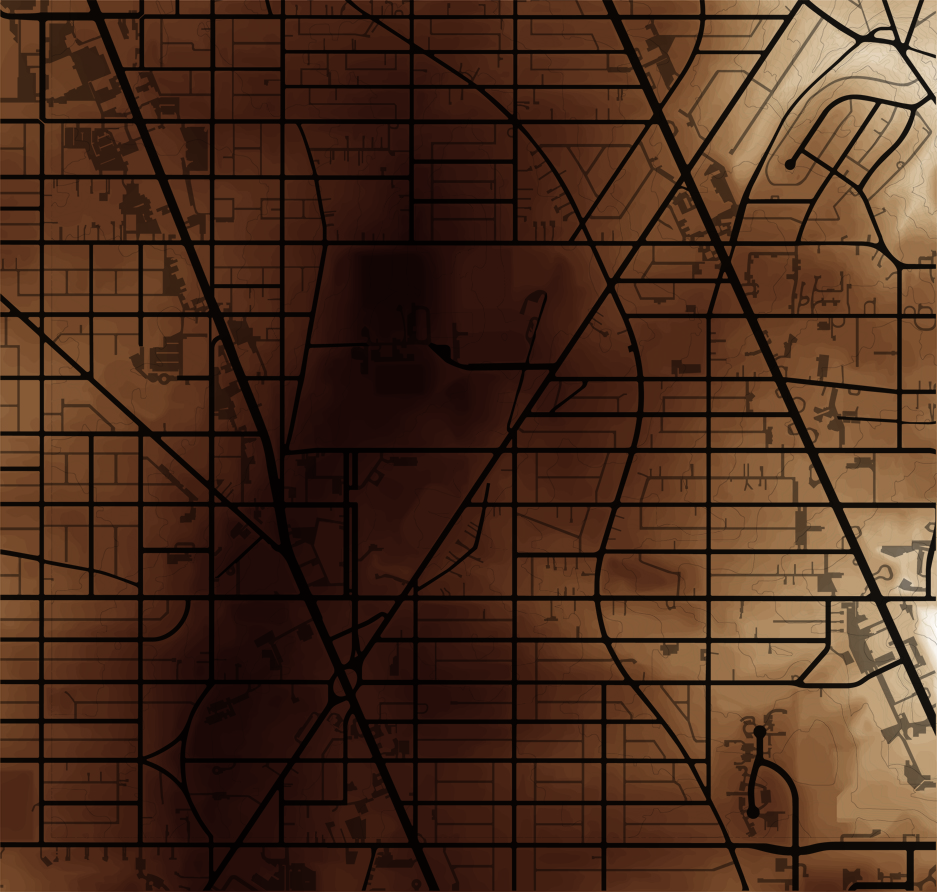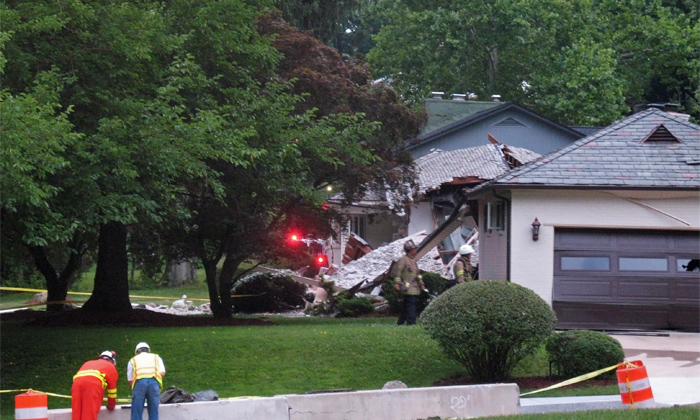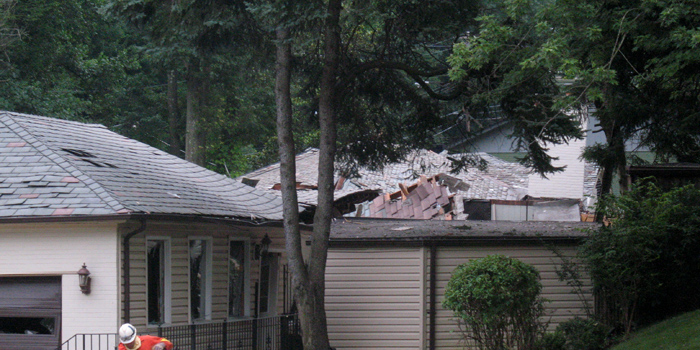Even without squinting, you can see diagonal lines that don’t seem to match up with any roads or lots. I’m fairly certain these cuts line up with older borders and roads, putting a whole new volume of evidence of the past fossilized in the modern legal form of the city. The erasure and remainder of various structures as a history appears too. Why did some lines stick around? Perhaps one owner sold out before the other, and a divided lot just went up for sale as two later. More comparisons under the fold.
When a concert isn’t just that
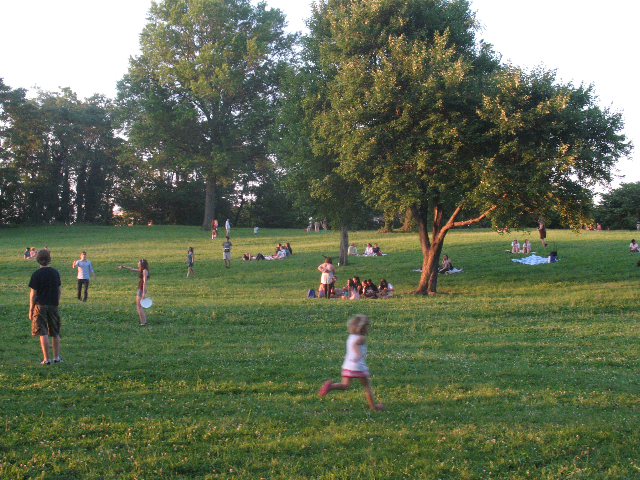
Last night began week five of this summer’s Fort Reno concerts. The annual series of musical triptychs, which take place in an improvised venue in the Tenleytown park, may be the most urbane happening of any place in DC. Amid the mild yellow-orange light of a summer evening, a small local band plays and a few hundred people of various ages watch while they sit on the grass. But beyond that and behind the stage, those less interested in the concert partake in all kinds of leisurely activity. Really, I’ve never seen the park so well used.
Out-of-District Experience: New Orleans, Louisiana
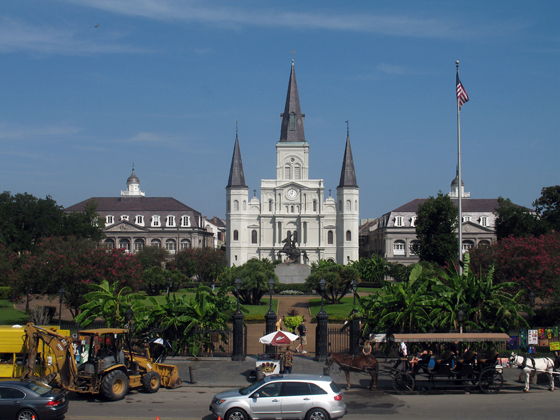
Toward the end of his career, Pablo Picasso lamented that he had stopped being creative and was merely “doing Picasso.” New Orleans has followed suit sometime in the past fifty years, becoming the image of the idea of itself. That doesn’t mean the jazz or the culture has disappeared, just that a simulacrum of itself has been interpolated into the French Quarter in such a way that a visitor can’t get a sense of the beast for all the taxidermy. I only had a morning to spend in the area due to nuptials elsewhere, but my perception was that there was a very livable area there, but what I saw did not inspire me to live there. I’ll need to go back and give the whole city a better look.
Continue reading ➞ Out-of-District Experience: New Orleans, Louisiana
Two big things happening tomorrow
Outside of DC, Joe Biden is in Ukraine. After the niceties of Obama’s visit to the Kremlin two weeks ago, Biden may be going over to reassure the shaken administration that the US is still an ally. On the other hand, the alleged “reset” of Russo-American relations and the tanking of the pro-wetern Ukrainian coalition would mean that his meeting with Yulia Timoshenko and Viktor Yuschenko could be both tense and unsatisfying. On Wednesday, the Vice President will be in Sakartvelo Georgia to speak to the parliament. Again, this meeting is a cautious attempt to maintain relations between the US and Russia’s prime enemies. Unlike the Baltic States and the Balkans, these countries are unstable and still sucsceptible to major influence. It will be interesting to watch the developments.
N.B. – Please do not refer to Ukraine as “The Ukraine,” as that implies that Kyiv is just some Russian border town. Украина literally means “hinterland” or “borderland,” but generally had its connotation set with a capital letter by the 18th Century. Only under the later Tsars and Soviets did the government take advantage of the lack of articles in Ukrainian to insist to western observers that the “Little Russians” did not deserve independence; it’s right there in the name, “our borderland.” If you’re under 30, you probably don’t make this mistake, but it still creeps into the news every once and a while to irritate sticklers like me.
Eatable Things: Italian Pizza Kitchen

Some DC stimulus information
For the cartophobic and verbal learners, a list of all the USDA and HUD programs in DC is available here, beginning toward the end of the page.
USDOT’s map lacks the visual breakdown to individual projects and uses a totally different base map, but it still has projects lists in a pop-up window. DC’s distribution claims to be largely railroad investment, but a quick look reveals that the sum includes the $1B grant given to Amtrak, as though DC is the only beneficiary.
Reno Park update 090712: Roads
After some hard importing/copying work and on-the ground observation, I’ve finally assembled this map of all legally marked streets and alleys in DC. Next up, sidewalks, then buildings and property, and finally land use. I’ll start doing mashup comparisons of these maps for the walkshed and green space requirements. Plus, I think I came up with an particularly useful modern variation on the Nolli Plan, which should make any archi-map geek excited. Comparisons to topography under the fold.
Generally, it’s interesting to see how the grid and the avenues flattened the topography. If I do a historical map, then the comparison would be fascinating, but historical topography is not relevant to my goals. Also note the amount of parking on the avenues, and how alleys nicely eliminate driveways in front of houses. Finally, Tenleytown is at the pass over the ridge line that begins at AU and ends near Chevy Chase. The hills and valleys in the area almost necessitated that the Georgetown-Frederick Pike go through this area at this spot.
Middle path density gets some news
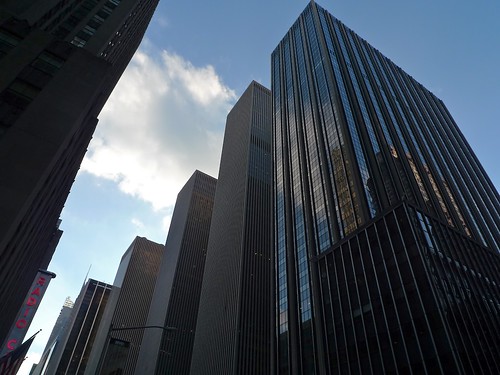
This past weekend, the East Bay Express (a paper in Oakland), wrote a fairly balanced article about the battles over densification in Oakland and Berkeley. Although it took as its subject a particularly acerbic debate over local development projects, the scenario is the same everywhere. The article presents three largely oppositional theses: tall buildings are environmentally sound, all density is environmentally unsound, and that density can mean Paris as well as Manhattan. Each one is given a fair voice, but ultimately only the middle path comes out looking informed.
Of course the commenters jumped out of the starting blocks and onto their respective causes: the electric car, renewable energy, zero population growth, THE IMPORTANCE OF WRITING EVERYTHING IN CAPITAL LETTERS, planting “subsistence” gardens in quarter-acre lots, and obviously the meme that developers are profiteers and gentrifiers. But what none of these people seemed to see was that the options of a pleasant human environment and a limited footprint on the natural world are not mutually exclusive.

Read the article; take a look at the section on pages 3 & 4 in particular, where Mike Pyatok, an architect with decades of experience, drops the usual truth bombs.
In an environment with artificial scarcity by way of outdated and strict zoning, the costs of land allotted to tall development, prices will be too high, even for luxury development. 5-8 story buildings are cheaper, more comfortable, and more energy efficient on a regional scale. Similarly, the need for a large footprint to justify the vertical costs means a less refined urban grain and less human-scale detail and fewer potential owners.
As long as cities are lusting for the skinny towers of 1920s New York, opponents will only see a superblock grime of the 1970s. Unfortunately, those skinny towers never made much money and definitely won’t nowadays. So, many opponents are simply reacting to unreasonable visions of the future with equally wrong visions of dystopia. Expect to see knees jerking until city councils and armchair planners ask for middle density.
Breaking the Transit Cartel
Through a complex network spanning at least four continents, [Gil] Peñalosa funnels innovations from one city to the next. Formerly the parks commissioner of Bogotá, Colombia — where his brother, Enrique, is known as the godfather of “Bus Rapid Transit” — Peñalosa is the mastermind behind the “Mexico City hop,” an intellectual property route whereby Latin American BRT cartels reach massive North American markets with an unslakeable thirst for surface transit improvements.
OK. Obvious parody. Yet when you read the New York Times article on the subject, you can see why satire can come so easily:
In the process, she has run up a travel bill of about $35,000, according to city records. And in some cases, Ms. Sadik-Khan has allowed outsiders, including transportation advocacy groups, to help foot the bill.
So, yes, she did what any professional of a certain caliber does, visiting example projects and speaking at conventions. Sadik-Khan is a professional, not a politician, so issues of working with advocacy groups and going to conferences are likewise professional. Admittedly, the Times is just reporting on something they found, but the conspiratorial tone over $470 airline flights and a total expense less than the Mayor’s monthly transportation costs is simply whacked. The Times has been playing to the highway set so desperately that they’ve lost credibility. Decent reporting, I suppose, but the creeping editorial is pathetic.
Explosion in Barnaby Woods
A gas leak in house at at 6120 Oregon Ave resulted in an explosion, partially destroying the one-story rambler. No one was hurt, as the residents were on vacation. Neighborhood residents reported a bomb-like sound, felt vibrations, and an air blast at around 6:30 on Saturday evening. Fire and rescue trucks from both DC and Maryland were at the site by within a few minutes, including a K9 team. Even at 8:00, when a Washington Gas team had already begun digging up the yard, the smell of the gas odorant still hung in the air.


